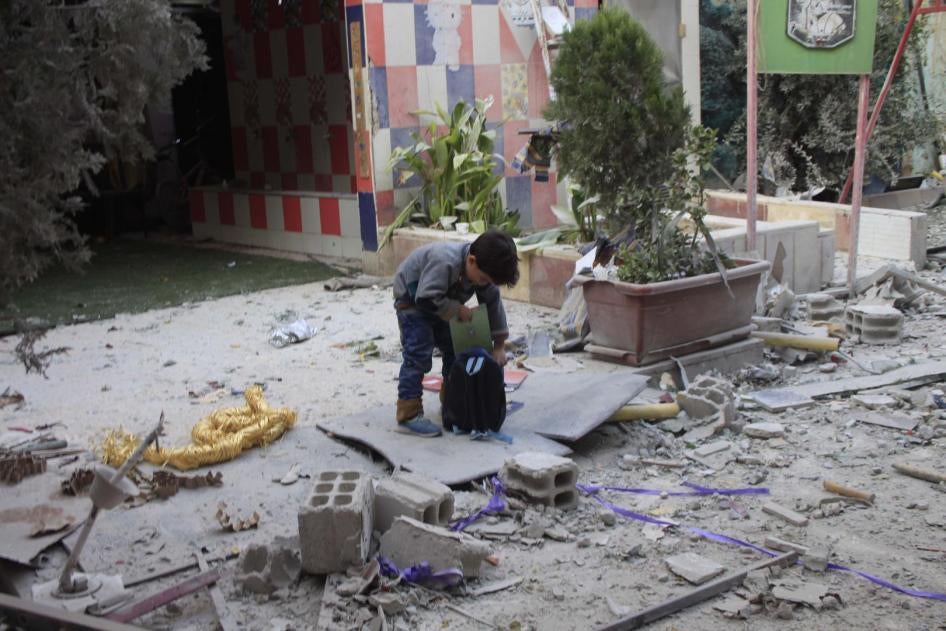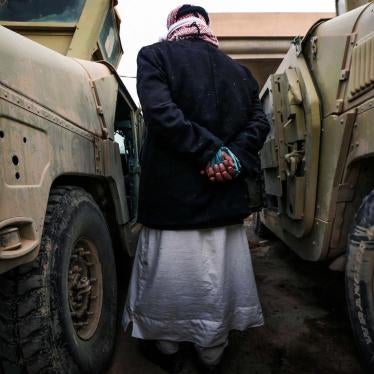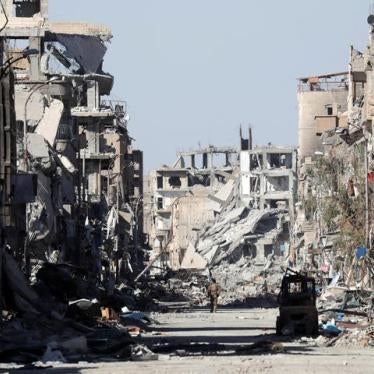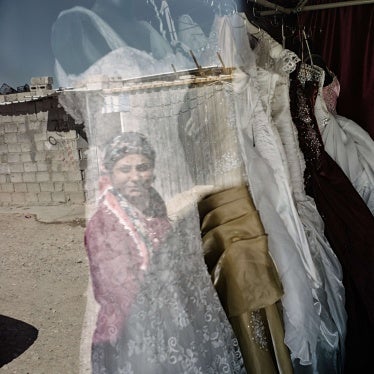(New York) – Attacks by Syrian-Russian forces in an area near the Damascus in late October and early November 2017 killed eight children and destroyed or damaged four schools, Human Rights Watch said today. The attacks on Eastern Ghouta, 15 kilometers from the Syrian capital, resulted in the closing of schools, depriving many children in the besieged area of access to education.
Impunity for unlawful attacks and a deadly siege of Eastern Ghouta by government forces mean that children in the enclave are at grave risk. The Syrian government and affiliated militia are on the United Nations’ “list of shame” of parties responsible for serious violations of the rights of children in armed conflict.
“Syrian and Russian forces appear to view the lives of children in Eastern Ghouta as utterly disposable,” said Bill Van Esveld, senior children’s rights researcher at Human Rights Watch. “The UN Security Council should demand an immediate end to all unlawful attacks, not least those killing children and destroying schools, under threat of targeted sanctions against those responsible.”
Human Rights Watch spoke to nine witnesses in November and reviewed photographs, videos, and reports by Syrian human rights and media organizations of the school attacks. The attacks were apparently indiscriminate, in violation of the laws of war.
The Syrian-Russian military alliance has attacked many of the towns in Eastern Ghouta repeatedly. Attacks on the enclave intensified after anti-government armed groups attacked Syrian forces at a frontline location in the area in mid-November, including the use of cluster munitions, and re-started after a brief lull in December. The Violations Documentation Center, a Syrian nongovernmental group, reported that Syrian and allied forces killed 45 boys and 30 girls in the Damascus suburbs from November 1 to January 3.
On the morning of October 31, a mortar round hit the entrance gate of a primary school in Jisreen, a town in the besieged enclave, killing six schoolboys and a man selling sweets from a cart. Half-an-hour later, two mortar rounds landed almost simultaneously, on either side of a school in the town of Mesraba, killing two adults and two children, including a father and his son. Attacks on November 8, including at least one airstrike, destroyed a kindergarten in the town of Hamouriyeh, and badly damaged two elementary schools in the towns of Saqba and Kafr Batna.
Residents and an education official from Eastern Ghouta told Human Rights Watch that in October schools in the area rescheduled and shortened class time from about 7 a.m. to 10:30 a.m. to keep children safe by reducing the time they were gathered together in classrooms. But attacks continued to kill and maim schoolchildren and forced emergency evacuations of schools and kindergartens. In November, local councils closed public schools in response to these dangers. In one community where a school was attacked, residents opened an “alternative” school in the basement of a residential building for greater safety, but an airstrike destroyed the building in December.
Anti-government armed groups, Faylaq al-Rahman and Jaysh al-Islam, control the towns where the schools were attacked. But residents said the armed groups did not have materiel or personnel in the towns, under agreements with local civilian councils. Witnesses and residents said that the mortar attacks originated from areas controlled by Syrian government forces that had been the source of previous and continuing attacks on the towns.
Syrian government forces have besieged Eastern Ghouta, which has a population of about 400,000, since 2013. In October 2017, the government restricted the only entry point for commercial merchandise, exacerbating a scarcity of food and medical supplies. The government has refused to allow in adequate humanitarian aid, which reached only about a quarter of the enclave’s residents in 2017, and unnecessarily hindered the evacuation of people with urgent medical needs.
At least three children died in November after Syrian authorities refused to permit their urgent evacuation for medical treatment unavailable in the enclave. UNICEF, the UN children’s agency, stated in December that 137 children needed immediate medical evacuation. But the government allowed the Syrian Red Crescent to evacuate only 17 children and 12 adults with life-threatening health conditions, and their family members, from December 27 to 29, reportedly as part of a deal in which Jaysh al-Islam released detainees. One of the children on the list of those due to be evacuated had already died, according to the Syrian American Medical Society, a nongovernmental group.
The laws of war that apply to all parties to the conflict in Syria prohibit attacks that target civilians or civilian infrastructure like schools, fail to distinguish between civilians and military objects, or disproportionately harm civilians. Parties are required to take all feasible measures in conducting operations to avoid, or in any event minimize, loss of civilian life, injury to civilians and damage to civilian objects. The laws of war also prohibit siege warfare if it causes disproportionate harm to the civilian population, and require the parties to provide access for humanitarian aid for civilians in need. Anyone who commits, aids, or abets serious violations of the laws of war intentionally or recklessly may be prosecuted for war crimes.
Russia has repeatedly used its veto as a permanent member of the UN Security Council to block accountability for war crimes by all sides in the Syria conflict. Russia and Syria should end their unlawful attacks on schools and civilians. The Security Council, which on December 19 renewed its mandate for cross-border delivery of humanitarian aid to millions of desperate Syrian civilians, should demand that the Syrian government immediately end unlawful restrictions on aid to Eastern Ghouta or face targeted sanctions against those responsible.
“In 2017 a mortar blew off a boy’s legs at his school gate, a warplane flattened a kindergarten, and children died from illnesses that could have been treated just a few kilometers away,” Van Esveld said. “The suffering of children in Eastern Ghouta should shock the conscience, but it continues unabated in 2018 as Russia and Syria persist in their unlawful attacks.”
October 31, 10:30 a.m.
Town of Jisreen, mortar attack, boys’ elementary school
Seven fatalities, including six children
Shortly after 10:30 a.m. on October 31, 2017, a single mortar round exploded immediately outside the entrance of an elementary school in the town of Jisreen, 10 kilometers east of central Damascus, witnesses told Human Rights Watch. Class had just ended, and children were leaving the school. According to the witnesses and family members, the attack killed six children, all under 12, and a man who sold sweets from a cart near the school gate, and wounded 15 to 20 other children, including a boy who lost both legs.
At that time, the nine schools in Jisreen were open only from 7 a.m. to 10:30 a.m., to reduce the risks to children if schools were attacked, a math teacher and an education official told Human Rights Watch. Mohamad Nasser Ash’oush elementary school had 520 students, all boys, in grades 1 through 6.
Bashar al-Bashash, the math teacher, who worked at the secondary school adjacent to the elementary school, was in the administration office when he “heard the sound of a [round] falling and the sound of children as they left at 10:30,” he told Human Rights Watch via WhatsApp messages. “We went out and saw them injured and on the ground. Everyone was crying and the whole place was filled with blood and torn remains.”
Bahjat Abou Ali, the director of a local center of the Syria Civil Defense, a search and rescue organization, said he “heard the sound of the [round] falling” and arrived at the school two minutes after the attack:
It was while students were on their way out of the school. It’s like they were waiting for the school bell to ring [to launch the attack]. They were at the entrance of the school buying sweets from one of the merchants, who also died. ... It was terrifying. Children were on the ground, remains, all on the ground. We grabbed whoever was alive and took them to the hospitals. There were 20 injuries among students. Jisreen hospital couldn’t take them all.
Witnesses and relatives identified the six children killed and provided photographs to Human Rights Watch: Yassin Ghaleb Hashem, Abdel Karim Mohamed Kheir Darwish, Yusuf al-Diyabi, Anas Mara’i, Mohamad Ma’moon Darwish, and Taher Jamil Darwish. The man killed while selling sweets near the school gate was Ghassan Abd el-Wahid Kateb, from Jobar.
Mohamad Darwish’s 17-year-old sister, Fatimah, said in text messages that he was 10 years old and in fourth grade. She said his family frantically searched for him after the attack:
People in the town started looking for their children in the emergency [rooms] and in front of the school, because there were many children who were injured or who died. We couldn’t find my brother at first because he was transported to a medical point outside of Jisreen, in Saqba, due to his serious injuries. Mohamad was the only boy in our family. In my family we’ve so far lost my brother, my uncle, my cousin, and five other cousins. In every home, there is sadness and fear. In every home, there is someone injured.
Photographs and videos posted online by local and regional news media groups show a small, shallow crater in the street a few meters outside the school gate, and severe fragmentation wounds to the lower legs of the wounded and dead, consistent with witnesses’ descriptions of a mortar projectile exploding on impact at street level.
The witnesses and residents said that the school was located between residential buildings in a civilian area with no fighters, visible materiel, or offices of armed opposition groups. The school had not been attacked previously, but mortar attacks have hit civilian objects in Jisreen regularly and apparently randomly, residents said. Jisreen is under the control of Faylaq al-Rahman, an anti-government armed group, according to the Syrian Organization for Human Rights, a nongovernmental group.
It was not possible to verify the site where the mortar was fired, but all witnesses affirmed they believed government forces had fired it. Al-Bashash, Abou Ali, and the others interviewed believed Syrian government forces in al-Mleiha, a frontline location two kilometers east, were responsible for the mortar attack, on the basis of earlier mortar attacks from the area. Al-Bashash said that the government Air Force Defense Directorate is in that area, and suspected that it was the source of the attack based on previous attacks from that location and its proximity to the town. The Education Office of the Jisreen Local Council also attributed responsibility to Syrian government forces, and posted photos it said were of the burial of victims.
Bassam al-Tunisi, head of press and public relations at the education office for 11 towns in Eastern Ghouta, told Human Rights Watch by phone that the academic year in the area began on September 19, but that most classes were suspended after the October 31 attacks on schools in Jisreen and Mesraba. “We took three days to mourn the dead but also we were afraid they’ll hit schools again.”
October 31, 11 a.m.
Town of Mesraba, mortar attack, girls’ elementary school
Four fatalities, including two children
Within an hour of the attack in Jisreen, between 11 a.m. and 11:30 a.m., two mortar rounds fell close to an elementary school in the nearby town of Mesraba, one on each side of the school. One projectile landed “right behind a wall of the school” and did not cause injuries, but the other landed almost simultaneously near another of the school compound’s exterior walls, killing four civilians including two children, a reporter with the Syrian Civil Defense center in Mesraba told Human Rights Watch in a phone call. Syrians for Truth and Justice, a nongovernmental group that interviewed a different Civil Defense worker and a resident of Mesraba, identified the school as the Shahid Soheil al-Tekhla school.
The mortar round killed Ghassan al-Kholi and his son, Mohamad; a young girl, Bara’a Talas; and another man, Adnan Ibrahim Anees, the reporter, the Civil Defense, and the Syria Violations Documentation Center said. Another child and two adults were wounded, the reporter said. All of those killed or wounded were civilians.
The reporter, who sent Human Rights Watch a graphic video he took at the scene, said the two mortar rounds “exploded at the very same moment.” When he and his colleagues rushed to the site of one explosion, they found no dead or wounded, but “the people there told us another [projectile] hit behind the back of the school.” At the site of the second impact:
We saw people and injuries on the ground, panic and fear. We started to rescue people, based on priority. We requested backup, another ambulance, and took all injuries to nearby hospitals. It’s a residential area and the school is between residential buildings, filled with people. There is no armed presence, nothing at all.
Mesraba is under the control of Jaysh al-Islam, an armed opposition group.
The civil defense reporter said that classes had ended and “children were just about to leave” when the attack occurred.A girl apparently wearing a backpack running away from the site is seen in the video. The reporter could not confirm the precise source of the attack, but believed the mortars were launched by government forces stationed at the Vehicles Administration Center (ادارة المركبات) near the town of Harasta, 1.5 kilometers away, because government forces there had previously launched indirect fire at Mesraba. Armed opposition groups in eastern Ghouta attacked the Vehicles Administration center two weeks later, on November 14.
November 8, 2:30 p.m.
Town of Hamouriyeh, airstrike, kindergarten
Three residents of Hamouriyeh told Human Rights Watch in separate telephone interviews that at about 2:30 p.m. on November 8, an airstrike with a single munition hit the Tamayuz (“Excellence”) kindergarten, destroying it. They said the building had not been used for military purposes and there were no military objects nearby.
No one was at the kindergarten because all schools in Hamouriyeh were closed from October 15 onward, said Ahmed Hamdan, a media activist who lives in the town. “There were no fatalities […] but it totally destroyed the school,” he said. “No one wants to go and die to study.”
Abdel Mun’em Issa, a local photographer, said: “It was total destruction. The [munition] hit in the middle of the school, and it went out of commission. It was just one [munition], but had a huge impact.”
Abdel Moyeen Homs, another resident, said he was “close to the kindergarten when it was struck” and heard a “very loud explosion. The bomb must have been highly explosive. When we went to the site, we realized it had destroyed the entire kindergarten and some of the houses next to it were heavily damaged.” Most people run for cover in basements whenever they hear a plane, Homs said, but the attack on the kindergarten wounded one man and one woman who were still in the street.
The kindergarten was for children aged 5 and 6, and had 250 students who attended in two shifts, Homs said, from 8 a.m. to noon, and from noon to 3:30 p.m. “If the school had been open, there would have been a massacre.”
The three men affirmed that the front lines were almost 3 kilometers from Hamouriyeh and that there was no military presence in the town.
The Hamouriyeh Media Office and Ghouta Media Center published multiple photographs and videos showing the damage to the kindergarten and nearby residential buildings. A nonprofit group, Al-Wafa’ for Relief and Development, published videos of a “festival” it held for orphaned children in the kindergarten two days before it was bombed.
While Human Rights Watch has not been able to determine whether the attacks were conducted by the Russian or Syrian air force, only Russian and Syrian forces are conducting airstrikes in the area.
Human Rights Watch documented that several airstrikes hit Hamouriyeh at about noon on December 3, one of which destroyed a building where residents had established an informal school – called an “alternative school” – in the basement, after public schools were out of service due to attacks.
November 8
Towns of Kafr Batna and Saqba
Two elementary schools badly damaged
Abou Ali, the director of a Syrian Civil Defense center in the area, said that an airstrike also hit a school in Saqba on November 8, “but thankfully no one was there at the time.” The local council of Saqba posted photographs on social media showing what it said was damage caused by the attack to the primary school; an Agence France-Presse photographer documented some of the destroyed classrooms.
Human Rights Watch has not been able to determine whether the attacks were conducted by the Russian or Syrian air force.
The Manarat al-Ola primary school in Kafr Batna, run by the Basmet Amal Foundation, was also badly damaged on November 8, by an unidentified munition. The school posted photographs showing the damage the following day; it had posted photographs of girls studying in un-damaged classrooms on November 5.
Previous attacks on Kafr Batna had forced the emergency evacuation of schools. On November 29, at about 11 a.m., an unidentified munition that local actors attributed to Syrian government forces exploded near a kindergarten in Kafr Batna. Abou Ali said he and his team responded at the scene: “It was terror and fear all over, we evacuated most children to shelters because the strikes never stopped. They were hitting while children were starting to leave [school]. Thankfully, no one died. One child had light injuries.” The Syrian Civil Defense and other local groups posted videos of children fleeing from the school.
Syrian human rights groups and local social media reported that an artillery attack by Syrian government forces on October 16 killed a girl, Basma Muhsen, and her mother Ibtisam, in Kafr Batna. Abou Ali said the attack was “near the school.”










